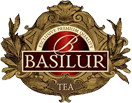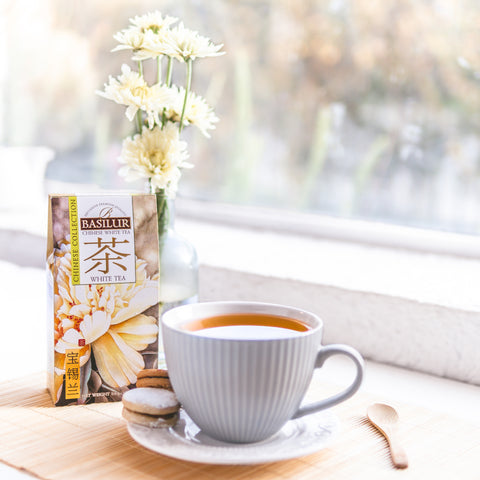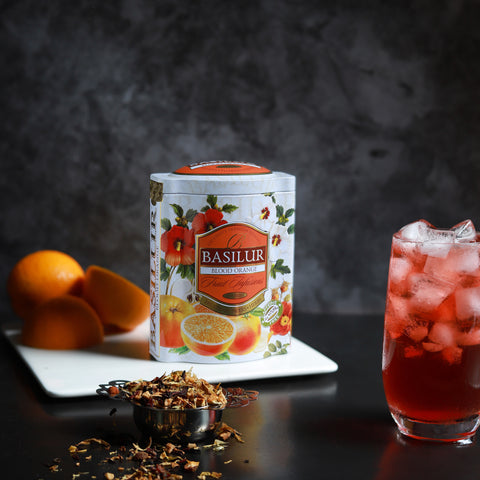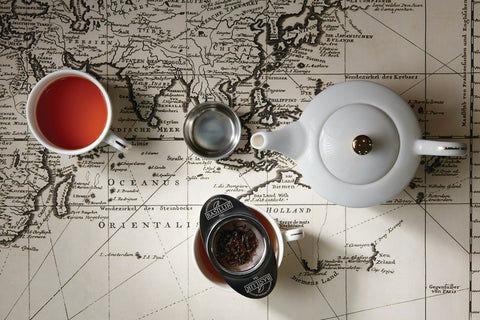The history of Chinese tea is a long and gradual story of refinement. Generations of growers and producers have perfected the Chinese way of manufacturing tea, and its many unique regional variations. The original idea is credited to the legendary Emperor Shennong, who is said to have lived 5 000 years ago. His far-sighted edicts required, among other things, that all drinking water be boiled as a hygienic precaution. A story goes that, one summer day, while visiting a distant part of his realm, he and the court stopped to rest. In accordance with his ruling, the servants began to boil water for the court to drink. Dried leaves from a nearby bush fell into the boiling water, and a brown substance was infused into the water. As a scientist, the Emperor was interested in the new liquid, drank some, and found it very refreshing. And so, according to legend, tea was created in 2737 BC.
Tea quickly became an extremely popular drink that became ingrained in Chinese culture. This led to the creation of numerous rituals and ceremonies surrounding tea since it was such an important part of Chinese lifestyle.

The special Chinese tea ceremony
While there are other Chinese tea ceremonies, the Gongfu tea ceremony dates back hundreds of years and is the most well-known. “Gongfu” means the art of doing something well, so this ceremony represents that philosophy—you are expected to invest the time, effort and care to create a true art-like tea experience. The style of Gongfu is something that can seem so understated and yet entirely change how you enjoy tea.
What do you need to create a Gongfu tea ceremony? For starters, a peaceful, calm setting which includes your state of mind. No feeling hurried, rushed, or stressed. That is most definitely not the Gongfu way. Next, select your tea. A traditional Gongfu tea uses an oolong tea, sometimes a pu-erh, but rarely a green tea. See the section below to learn more about Chinese teas. You can select the finest tea in the world, this is what we are known for at Basilur, but if your water is substandard you’ve just sabotaged the whole process. Use only the purest, cleanest water. Not only will your taste buds and your guests thank you, but in a nod to the spiritual nature of the Chinese, you’ll be paying homage to nature and the Earth’s elements as well.

The different types of Oriental Tea
Green Tea
Green tea is the most natural of the tea varieties. Although a number of different green tea production methods exist, the most common form involves young tea leaves that are dried as soon as they are picked so as to retain as many of their natural compounds as possible. This gives the tea a light, astringent flavor and makes it rich in antioxidants. The most famous type of green tea is Dragon Well tea (Long Jing), produced in Hangzhou.
White Tea
Like green tea, white tea undergoes minimal processing. Although definitions differ, it is generally accepted that white tea is never rolled or oxidized, giving it a very light flavor. The name is derived from the silvery-white hairs that cover the buds of the tea plant.
Oolong Tea
Oolong falls somewhere in between green and black tea in terms of flavor, being semi-oxidized. The taste is fairly mild but it is stronger than you think, so do not underestimate it! The most famous types of oolong tea are Iron Buddha (tie guan yin) from Fujian and Big Red Robe (da hong pao) from the Wuyi Mountains.
Yellow Tea
Yellow tea is one of the rarer and more expensive varieties of tea. It is produced by allowing the damp leaves to dry naturally under a cloth, giving it a mellower and less astringent taste than green tea. It was traditionally served in the imperial court, since yellow was an imperial color. Junshan Yinzhen from Hunan province is the best-known yellow tea.
Black Tea
Confusingly, black tea is actually called red tea (hong cha) in Chinese, referring to the color of tea once it is brewed. The leaves go through several processes, including, drying, oxidation, and roasting, which gives the tea its signature black color. One of the most popular types of black tea is Keemun (qimen) from Anhui province and Lapsang Souchong (zhengshan xiaozhong), which is smoked over burning pine, giving it its unique flavor.
Post-fermented Tea
The most famous variety of fermented tea in China is Pu-erh from Yunnan province. After being rolled and dried, the tea leaves undergo a process of microbial fermentation for anything from several months to many years. Pu-erh is usually sold in round bricks, which are marked with the year and region of production. Pu-erh is considered to be very good for digestion and is often served with rich meals such as dim sum.
As you can see, tea is more than just a beverage or an industry in China. It is a way of life and part of Chinese culture. Tea continues to play a significant role in Chinese culture to this day. Apart from being drunk during meals, it is common to offer tea to one’s guests, and to perform tea ceremonies during weddings and Chinese New Year. At Basilur, we have paid homage to this rich history of Chinese tea through Basilur's Chinese collection, a diverse collection of some of the finest teas prepared by following the customs and traditions of the Orient!




Comments (0)
There are no comments for this article. Be the first one to leave a message!